A bird's eye view of the Cup
Sochi, Russia -- It’s a really strange feeling, looking at 22 men running seven floors below you. As long as I look at the game below through my lens, then I’m all right. But if I look at it with my own eyes, I start to get dizzy, even though I’m not afraid of heights.
I have been covering many of the matches on what we call a catwalk -- the space just below the roof. It’s the first time that AFP has covered a World Cup like this and it makes for some astonishing angles and images. Some of the pictures are just amazing, because we’re not used to seeing the action of a World Cup game from above.
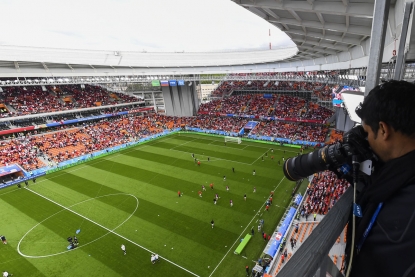 (Photo courtesy of Jewel Samad)
(Photo courtesy of Jewel Samad)So far, I have covered matches from this position in Rostov-on-Don, Yekaterinburg and Sochi. We haven’t been given permission to shoot yet in Moscow and not sure if we’ll get it.
To work at such heights, I needed training and took a course in Bangkok, where my coach taught me how to dress and behave so that nothing falls -- things dropped from such a height can become deadly, so you have to be super careful. After the course, I got to practice using safety gear at a makeshift structure at the training center in Bangkok, where I’m currently based.
 Portugal's forward Cristiano Ronaldo at the Fisht Stadium in Sochi on June 30, 2018. (AFP / Kirill Kudryavtsev)
Portugal's forward Cristiano Ronaldo at the Fisht Stadium in Sochi on June 30, 2018. (AFP / Kirill Kudryavtsev)I wear pants with zipped pockets, to make sure nothing falls from them. All of the stadiums have been very strict about safety, but frankly, it’s pretty safe on the catwalk itself, there is very little chance of falling, with a walkway about three feet (about a meter) wide.
As my colleague Kirill Kudryavtsev, who has also been shooting from up high during this tournament, says, you have to take things slowly when you’re up there. “You have to do everything slowly and not even think of running or doing a fast move.”
Kirill had unique training to work at heights like these -- he regularly covers launches of the Soyuz rockets from Baikonur, where he has to climb on the tower to set up the remote equipment... and then back up again after the launch, to get it back.
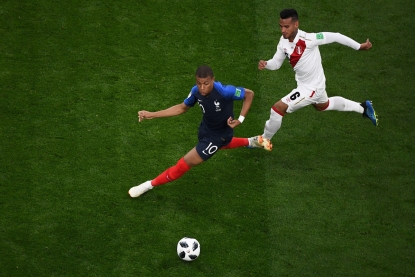 France's forward Kylian Mbappe (L) and Peru's defender Miguel Trauco at the Ekaterinburg Arena in Ekaterinburg on June 21, 2018. (AFP / Jewel Samad)
France's forward Kylian Mbappe (L) and Peru's defender Miguel Trauco at the Ekaterinburg Arena in Ekaterinburg on June 21, 2018. (AFP / Jewel Samad)When I’m up there, I’m completely on my own. It’s a strange feeling to be alone shooting a World Cup match -- when I’m down on the field, I’m with dozens of other photographers, sitting shoulder to shoulder all around the pitch.
I am usually allowed access about two hours before a match starts. Access in most of the stadiums has been easy -- it’s just a matter of climbing stairs. In Yekaterinburg, though, I had to climb a ladder. With 20 kilos of equipment in my backpack and a camera around my neck, that was quite a climb. I literally took it one step at a time.
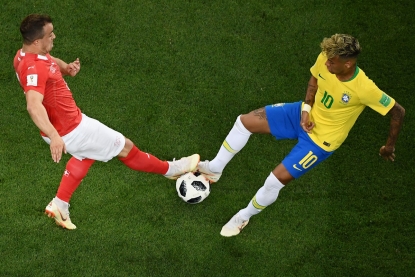 Brazil's forward Neymar (L) vies with Switzerland's forward Xherdan Shaqiri during the Russia 2018 World Cup Group E football match between Brazil and Switzerland at the Rostov Arena in Rostov-On-Don on June 17, 2018. (AFP / Jewel Samad)
Brazil's forward Neymar (L) vies with Switzerland's forward Xherdan Shaqiri during the Russia 2018 World Cup Group E football match between Brazil and Switzerland at the Rostov Arena in Rostov-On-Don on June 17, 2018. (AFP / Jewel Samad)Between getting up there and the shooting itself, the whole thing can get quite tiring. I bring dried fruit with me and water, but I have to be careful about how much fluid I drink because there are no toilets around and nature’s calls have to wait until the end of the match and the climb down.
The shooting itself is pretty challenging. Because I’m so far away, I have to use a big lens, a 500mm that weighs about six kilos. I carry it around my neck for the whole match, and after more than an hour and a half it can get pretty heavy. To prevent any accidents, I also have two safety cables attached to the railing, one to the camera and one to the lens.
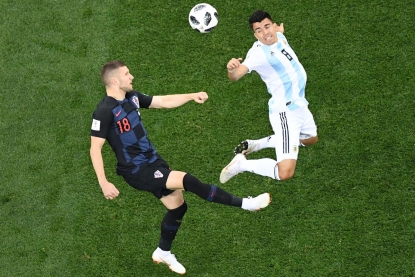 Croatia's forward Ante Rebic (L) vies Argentina's defender Marcos Acuna during the Russia 2018 World Cup Group D football match between Argentina and Croatia at the Nizhny Novgorod Stadium in Nizhny Novgorod on June 21, 2018. (AFP / Kirill Kudryavtsev)
Croatia's forward Ante Rebic (L) vies Argentina's defender Marcos Acuna during the Russia 2018 World Cup Group D football match between Argentina and Croatia at the Nizhny Novgorod Stadium in Nizhny Novgorod on June 21, 2018. (AFP / Kirill Kudryavtsev)I usually stay on one side of the field and then change at halftime. Or I will stay above the bench of the better team, since generally players run toward their bench after scoring.
When AFP first asked me to work from up above, I had mixed feelings. I am used to working from the field. But it was a challenge to do something new, so I gave it a try. It’s turned out to be really interesting because the pictures come out really well.
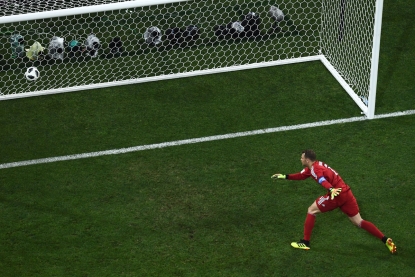 Germany's goalkeeper Manuel Neuer reacts after conceding during the Russia 2018 World Cup Group F football match between Germany and Sweden at the Fisht Stadium in Sochi on June 23, 2018. (AFP / Jewel Samad)
Germany's goalkeeper Manuel Neuer reacts after conceding during the Russia 2018 World Cup Group F football match between Germany and Sweden at the Fisht Stadium in Sochi on June 23, 2018. (AFP / Jewel Samad)




